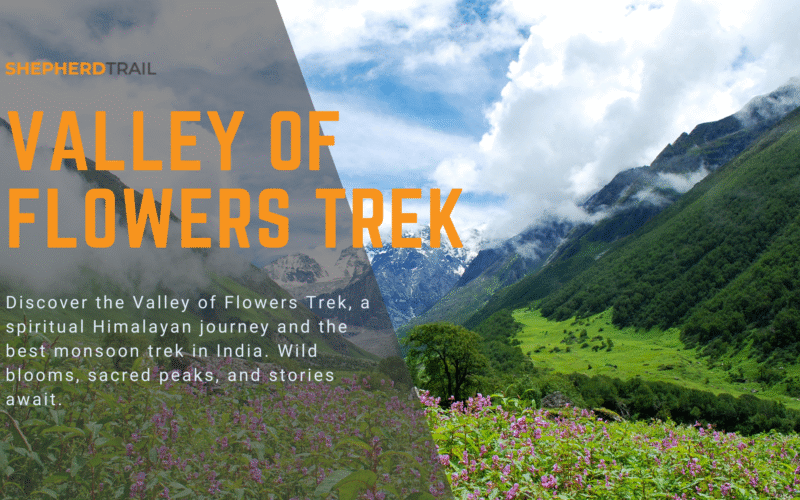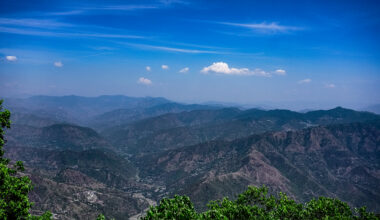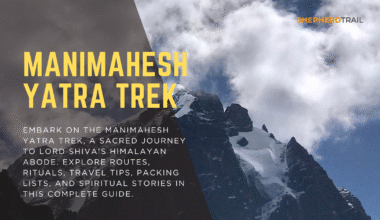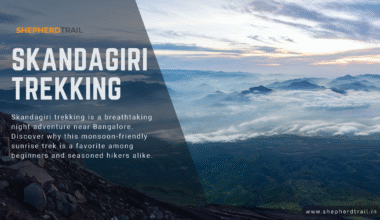Valley of Flowers Trek – A Himalayan Tapestry Woven in Bloom
Where Every Trail Tells a Story – ShepherdTrail
There are treks that test your limits, and then there are treks that heal you. The Valley of Flowers Trek belongs to the latter. Nestled deep in the Garhwal Himalayas of Uttarakhand, this trail feels like a dream you once had — wildflowers carpeting the valley floor, snow-capped peaks standing silent guard, and an air so pure it almost hums with divinity.
But more than the visual grandeur, this trek is about awakening something ancient within you. Every step through this UNESCO World Heritage Site feels like stepping into an old myth — one where gods walked and sages meditated. No wonder it’s often hailed as the best monsoon trek in India.
Why the Valley of Flowers is More Than Just a Pretty Place
As trekkers, we often chase summits. But what if the trail itself was the destination? What if the journey wasn’t upward but inward?
The Valley of Flowers — or Phoolon Ki Ghati as the locals call it — is a high-altitude Himalayan valley located at around 3,658 meters, cradled between the Zanskar and Great Himalayan ranges. It bursts into a kaleidoscope of colors each monsoon, between mid-July and August, when hundreds of species of alpine flowers bloom together.
What makes it special?
-
Spiritual backdrop: Just ahead lies Hemkund Sahib, a revered Sikh pilgrimage site at 4,329 m.
-
Biodiversity: You’ll witness rare flowers like blue poppies, cobra lilies, and brahma kamal (especially en route to Hemkund).
-
Legends abound: Locals believe that this is the place from where Hanuman brought Sanjeevani Booti to save Lakshman during the Ramayana.
Itinerary – The Story Unfolds One Trail at a Time
Let’s walk you through the trail — not just as an itinerary, but as a journey of discovery.
Day 1: Rishikesh/Haridwar to Govindghat (1,828 m)
After an overnight train or bus from Delhi, you arrive at Rishikesh or Haridwar and begin your long yet scenic road journey to Govindghat via Joshimath. The route traces the Alaknanda River, cutting through the mystical towns of Devprayag, Rudraprayag, and Karnaprayag — confluences that seem to pull at your spirit.
Night halt at Govindghat. Acclimatize well — the mountains ahead demand your humility.
Day 2: Govindghat to Ghangaria (approx. 13–14 km including motorable)
A short motorable drive (around 3–4 km) takes you from Govindghat to the village of Pulna, the true starting point of the trek.
From Pulna, a 10–11 km uphill trail leads you to Ghangaria. The path, although well-defined, winds through pine forests, waterfalls, and wooden bridges that creak under stories of pilgrims past. The air smells of wet earth and wild rhododendron.
Ghangaria is a small settlement serving as the base for both the Valley of Flowers and Hemkund Sahib. This is your last point of accommodation before stepping into wilderness and wonder.
Day 3: Ghangaria to Valley of Flowers and back (8–10 km round trip)
You wake early, pack light, and enter the Valley of Flowers National Park. The entrance lies about 3.5–4 km from Ghangaria, and how far you walk inside the valley depends on your pace and curiosity. Most trekkers cover around 8–10 km round trip, soaking in the splendor.
As the forest opens, the first glimpse of the valley hits you like poetry — stretches of pink, yellow, blue, and violet sway with the wind. Clouds roll down to kiss the blooms. Streams rush by, fed by glacial melt. Every stone here feels ancient, every flower a messenger.
You don’t just walk — you pause, observe, kneel, whisper a thank-you.
Biodiversity is rich, with species like the Himalayan blue poppy, Himalayan bellflower, and anemones. While sightings of musk deer or monals are possible, large mammals like the Himalayan bear are extremely rare — and should never be sought or approached.
Day 4: Optional Hemkund Sahib Trek or Rest Day (12 km round trip)
If your legs and lungs allow, take the steep, demanding trail up to Hemkund Sahib, one of the highest Gurudwaras in the world. The altitude gain is significant — from 3,050 m to 4,329 m — and the 6 km climb is steep, cold, and can be slippery in monsoon. But the reward is profound.
The Brahma Kamal — a sacred alpine flower — blooms only at such elevations. The lake beside the Gurudwara reflects the peaks like a mirror, and chants fill the thin air with a sense of stillness.
Alternatively, spend the day in Ghangaria journaling your thoughts, reading about local myths, or speaking with other trekkers. Sometimes, silence is the most honest form of reflection.
Day 5: Ghangaria to Govindghat – Return Trek
Retrace your steps back to Pulna and take the ride to Govindghat. You walk familiar paths, but you are no longer the same.
Spiritual Insights – A Valley that Teaches Silence
The Valley of Flowers Trek is less about conquering nature and more about surrendering to it.
You won’t find loud pilgrims or blazing summit flags here. Instead, you’ll meet stillness. A kind that sits in your chest and makes you want to whisper instead of speak.
It reminds one of the peace at Himani Chamunda, the sunrise ridge of Thatharna, or Kareri Lake’s glass-still waters — trails where solitude is the teacher, and nature the guru.
The Valley doesn’t shout for attention. It waits. And when you finally arrive, you realize that the most sacred shrines aren’t always temples — sometimes they’re valleys, blooming without expectation.
Why Valley of Flowers is the Best Monsoon Trek in India
Among the many trails that crisscross the Himalayas, Valley of Flowers stands out as the best monsoon trek in India — and with good reason.
Here’s why:
-
Seasonal spectacle: While most Himalayan trails are dangerous in the rains, this one thrives during monsoon.
-
Accessible yet immersive: Though remote, it doesn’t require technical skills or high-altitude gear.
-
Safe and well-marked: Unlike sharp ridgelines on treks like Indrahar Pass, this one’s ideal for solo travelers, families, and spiritual seekers alike.
Every flower here whispers a secret. And if you listen carefully, you’ll find the monsoon isn’t just about mud and rain — it’s about life unfurling in its most vibrant form.
Essential Trek Info
-
Region: Chamoli District, Uttarakhand
-
Altitude: Valley at ~3,658 m | Hemkund Sahib at 4,329 m
-
Trek Grade: Easy to Moderate (steep climb to Hemkund Sahib is more demanding)
-
Duration: 5–6 days from Rishikesh/Haridwar
-
Trek Distance: ~38–40 km total (including Hemkund)
-
Park Open: June 1 to October 31
-
Best Bloom Period: Mid-July to August (peak); June and September offer unique beauty
-
Entry Permit: Mandatory, available at Ghangaria Forest Gate
-
Accommodation: Guesthouses and hotels in Ghangaria and Govindghat (not traditional homestays)
Gear Guide – Travel Light, Pack Smart
The monsoon makes this trail both magical and tricky. Here’s what to carry:
Clothing:
-
Waterproof poncho or rain jacket
-
Quick-dry pants and base layers
-
One warm fleece or padded jacket
-
Wool cap, sun cap, gloves
-
Trekking shoes with strong grip (Quechua MH500 ideal)
Essentials:
-
Waterproof backpack (30–40L)
-
Trekking pole (Forclaz MT100 recommended)
-
Headlamp, power bank, and dry snacks
-
First aid kit, water purification tablets
-
ID card, extra passport-size photos for permits
Trail Tips from ShepherdTrail
-
Start early to avoid afternoon clouds and fog.
-
Respect the silence of the Valley — speak less, observe more.
-
Don’t overextend into the Valley on a single day. Plan a second visit if needed.
-
Altitude can hit hard — especially on the Hemkund climb. Take breaks and hydrate well.
-
Preserve the place: Don’t pick flowers or litter — leave the trail better than you found it.
Final Words – When Nature Becomes Prayer
There are places you trek for adventure, and others you walk for healing. Valley of Flowers is the latter — a place that doesn’t challenge your strength but invites your stillness.
It doesn’t thrill, it transforms.
Just like the mystical quiet at Indrahar Pass, the stillness of Kareri Lake, or the sunrise solitude of Thatharna, this trek reminds you that you are part of something larger. Something sacred.
So if your soul craves not just views but meaning, if you seek not just paths but purpose — the Valley of Flowers is calling.
And you must go.






